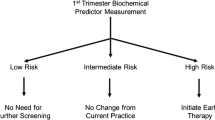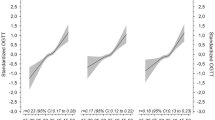Abstract
Early pregnancy prediction of third trimester glucose intolerance may identify a population of women whose trajectory toward gestational diabetes mellitus (GDM) is modifiable. We assessed whether first trimester glycated hemoglobin (HbA1c) and sex hormone-binding globulin (SHBG), markers of insulin resistance, predicted third trimester glucose intolerance. Nondiabetic women with singleton pregnancies enrolled in a prospective observational study, 11 0/7 to 14 6/7 weeks. At enrollment, maternal characteristics, medical history, and blood samples were collected for HbA1c and SHBG. Two-step GDM screening was performed, 22 0/7 to 33 6/7 weeks. A 50 g oral glucose tolerance test ≥ 130 mg/dL defined screen positive, or glucose intolerance. Carpenter-Coustan criteria diagnosed GDM. Means HbA1c and SHBG were compared between glucose-intolerant versus normoglycemic women, and GDM versus no GDM women. We report unadjusted and adjusted odds ratios (OR; 95% confidence interval [CI]) of regression analyses. Adjusted models include race, enrollment body mass index, and history of GDM. Among 250 women, 29% were glucose intolerant and 6% had GDM. Among glucose-intolerant women, HbA1c was higher (5.3 ± 0.3 vs. 5.1 ± 0.3, P = .01) and associated with glucose intolerance in unadjusted, but not adjusted, models (OR: 2.9, 95% CI: 1.2–7.1; adjusted odds ratio [aOR]: 2.0, 95% CI: 0.7–5.4). Among GDM women, HbA1c was higher (5.4 ± 0.4 vs 5.2 ± 0.3, P = .002) and SHBG was lower (228 ± 72 vs 288 ± 93 mmol/L, P = .02). The HbA1c predicted GDM in unadjusted (OR: 13.2,95% CI: 2.6–68.0) but not adjusted (aOR: 6.7, 95% CI: 0.8–55.2) models. Although metabolic alterations may well precede third trimester glucose intolerance, neither HbA1c of SHBG remained an independent predictor of glucose intolerance or GDM in adjusted models.
Similar content being viewed by others
References
Bantle JP, Wylie-Rosett J, Albright AL, et al. Nutrition recommendations and interventions for diabetes: a position statement of the American Diabetes Association. Diabetes Care. 2008; 31(suppl 1):S61–S78.
Dabelea D, Snell-Bergeon JK, Hartsfield CL, Bischoff KJ, Hamman RF, McDuffie RS. Kaiser Permanente of Colorado GDM Screening Program. Increasing prevalence of gestational diabetes mellitus (GDM) over time and by birth cohort: Kaiser Permanente of Colorado GDM Screening Program. Diabetes Care. 2005;28(3):579–584.
Falavigna M, Schmidt MI, Trujillo J, et al. Effectiveness of gestational diabetes treatment: a systematic review with quality of evidence assessment. Diabetes Res Clin Pract. 2012;98(3):396–405.
Metzger BE, Lowe LP, Dyer AR, et al. Group HSCR Hyperglycemia and adverse pregnancy outcomes. N Engl J Med. 2008;358(19):1991–2002.
Langer O, Yogev Y, Most O, Xenakis EM. Gestational diabetes: the consequences of not treating. Am J Obstet Gynecol. 2005;192(4):989–997.
Berggren EK, Boggess KA, Jonsson Funk M. Population health: modest glycaemic improvements in a pregnant cohort with mild glucose intolerance decreased adverse outcomes. Paediatr Perinat Epidemiol. 2014;28(4):280–286.
Berggren EK, Boggess KA, Stuebe AM, Jonsson Funk M. National Diabetes Data Group vs Carpenter-Coustan criteria to diagnose gestational diabetes. Am J Obstet Gynecol. 2011;205(3): 253.e1–e7.
Katon J, Williams MA, Reiber G, Miller E. Antepartum A1C, maternal diabetes outcomes, and selected offspring outcomes: an epidemiological review. Paediatr Perinat Epidemiol. 2011;25(3):265–276.
Leipold H, Worda C, Ozbal A, Husslein P, Krampl E. Firsttrimester nuchal translucency screening in pregnant women who subsequently developed gestational diabetes. J Soc Gynecol Investig. 2005;12(7):529–532.
Balaji V, Madhuri BS, Ashalatha S, Sheela S, Suresh S, Seshiah V. A1C in gestational diabetes mellitus in Asian Indian women. Diabetes Care. 2007;30(7):1865–1867.
Smirnakis KV, Plati A, Wolf M, Thadhani R, Ecker JL. Predicting gestational diabetes: choosing the optimal early serum marker. Am J Obstet Gynecol. 2007;410(4):410.e411–416; discussion 410. e6-e7.
Nanda S, Savvidou M, Syngelaki A, Akolekar R, Nicolaides KH. Prediction of gestational diabetes mellitus by maternal factors and biomarkers at 11 to 13 weeks. Prenat Diagn. 2011;31(2):135–141.
Thadhani R, Wolf M, Hsu-Blatman K, Sandler L, Nathan D, Ecker JL. First-trimester sex hormone binding globulin and subsequent gestational diabetes mellitus. Am J Obstet Gynecol. 2003;189(1):171–176.
Carpenter MW, Coustan DR. Criteria for screening tests for gestational diabetes. Am J Obstet Gynecol. 1982;144(7):768–773.
Starikov R, Bohrer J, Goh W, et al. Hemoglobin A1c in pregestational diabetic gravidas and the risk of congenital heart disease in the fetus. Pediatr Cardiol. 2013;34(7):1716–1722.
Fong A, Serra AE, Gabby L, Wing DA, Berkowitz KM. Use of hemoglobin A1c as an early predictor of gestational diabetes mellitus. Am J Obstet Gynecol. 2014;641(6):641.e1-e7.
Hanson RL, Imperatore G, Bennett PH, Knowler WC. Components of the “metabolic syndrome” and incidence of type 2 diabetes. Diabetes. 2002;51(10):3120–3127.
Sattar N, McConnachie A, Shaper AG, et al. Can metabolic syndrome usefully predict cardiovascular disease and diabetes? Outcome data from two prospective studies. Lancet. 2008;371(9628):1927–1935.
Pan ML, Chen LR, Tsao HM, Chen KH. Relationship between polycystic ovarian syndrome and subsequent gestational diabetes mellitus: a nationwide population-based dtudy. PLoS One. 2015; 10(10):e0140544.
Theriault S, Giguere Y, Masse J, Girouard J, Forest JC. Early prediction of gestational diabetes: a practical model combining clinical and biochemical markers. Clin Chem Lab Med. 2016;54(3):509–518.
American Diabetes Association. Diagnosis and classification of diabetes mellitus. Diabetes Care. 2013;36(suppl 1):S67–S74.
Author information
Authors and Affiliations
Corresponding author
Rights and permissions
About this article
Cite this article
Berggren, E.K., Boggess, K.A., Mathew, L. et al. First Trimester Maternal Glycated Hemoglobin and Sex Hormone-Binding Globulin Do Not Predict Third Trimester Glucose Intolerance of Pregnancy. Reprod. Sci. 24, 613–618 (2017). https://doi.org/10.1177/1933719116667230
Published:
Issue Date:
DOI: https://doi.org/10.1177/1933719116667230




